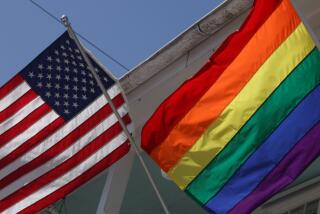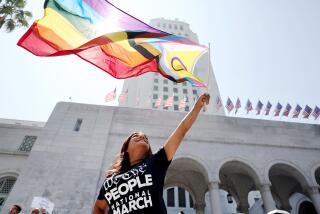PERSPECTIVE ON GAY RIGHTS : 1% or 10%--the Law Isn’t Counting : How many homosexuals there are has no bearing on the validity of their claim to equal standing under the Constitution.
- Share via
The just-released survey by the Alan Guttmacher Institute, which estimates a far lower percentage of homosexuals among American men than had been widely believed for 40 years, is bound to kick up a fuss. One can already hear the sound bites about “fewer gays” and the “I told you so’s” from the anti-homosexual activists, followed by defensive positioning from the gay and lesbian spokespeople. Before we get too deep into such discussion, some clarifications are in order. Gay/lesbian rights has never been a statistically based claim because, like all Constitution-based claims for equal protection of the laws, gay rights is about the rights of individuals.
“Minority rights” is the way we refer to the classes of individuals who are discriminated against and seek redress as a group. Whether everyone in the group has some things in common is not the key to their claim for equal protection of the laws. A minority’s percentage of the population has nothing to do with the rights of the individuals who are being denied equal protection because they happen to be in that minority.
Lesbian and gay Americans have come together in a civil-rights movement as a vast collection of individuals who recognize a common civil disenfranchisement on account of a common minority status--in this case, the minority sexual orientation of preferring same-sex partners.
As anyone involved in a leadership position in the gay movement will tell you, there is little unanimity. This movement has always been and will remain a movement of highly individualized individuals. Because of what we have to go through to come out in a heterosexual society, lesbians and gays make better leaders than followers. The movement is, above all, a movement of individuals seeking the constitutional protections for individuals that are the hallmark of the American system of governance. Next week, when an anticipated 1 million lesbians and gays converge on Washington to demonstrate for our rights, we will be there en masse as individuals.
For purposes of the Constitution, lesbian and gay Americans just happen to be homosexual and encounter discrimination because of that immutable characteristic. The question of what homosexuals do or do not have in common across gender, race and cultural lines, and the question of whether there is a gay culture or a lesbian culture are critical and important discussions, but they have nothing to do with equal rights as individually based claims for equal protection of the laws. Our private lives, like everyone’s, are our own business and nobody else’s.
The systematic denial of equal protection to homosexuals is not and never has been based on our numbers. It is true that the fewer of us there appear to be, the easier it is for our just claims to be ignored. The Guttmacher survey should make no difference in the straight majority’s consideration of gay rights, but, before its findings are taken too seriously, it should be remembered that they were established by interviewing American men in their 20s and 30s. When, after World War II, Alfred Kinsey was surveying Americans’ sexual behavior, his questions were asked of a more naive population, which did not routinely connect sexual acts with sexual orientation or identity. It is hard to imagine in our time young American males answering questions about sex without a consciousness of what it would mean to them to identify as homosexual. Indeed, the whole question of disclosure of one’s gayness is so freighted with the American culture’s active discouraging of gays to come out that it is hard to imagine an accurate survey.
The prejudice and one’s concern about these surveys goes to the core of the issues raised by gay civil rights. It will be interesting to know some day how many lesbian and gay Americans there really are. We will have that information only when it is no longer necessary for homosexuals to hide their identities, and that will come after the granting of equal protection of the laws.
It is the purpose of the movement against gay rights to keep us silent, to pretend that there are fewer of us than there are. Arguments against extending equal protection of the laws to lesbian and gay Americans boil down to an aggressive minority’s dislike of homosexuality and a majority’s acquiescence in their prejudice.
Gays’ rights do not infringe on the rights of others to hold their own religious and personal views. But the same Constitution that guards their freedom to do so also and equally protects the rights of gay men and lesbians to get on with their lives, secure in the enjoyment of basic protections of the law, including property rights, employment rights, protection from violence and equal access to the benefits of the law.
Civil-rights campaigns often confront prejudice and fear, and it is understandable that they summon statistical evidence to persuade their fellow citizens of their rights to an equal share of democracy. One strategy of the gay-rights movement has been to remind our fellow citizens how many of us there are. Kinsey’s familiar figure of 10% was useful shorthand, but statistics cannot substitute for, let alone constitute, fairness. The relevant percentage is not how many young men say they are gay. Pay attention to the percentage that never changes: the 100% of Americans who, as individuals, claim equal protection of the laws of the United States.
On April 25, when a million of us gather in Washington, we may be 10%, we may be 90% or, if the Christian right is to be believed, 200% of all homosexuals. The point is that we will be there, not only for our own individual rights, but because we know what most Americans know, which is that the individual rights of each American depend on the individual rights of every American.
More to Read
Sign up for Essential California
The most important California stories and recommendations in your inbox every morning.
You may occasionally receive promotional content from the Los Angeles Times.










